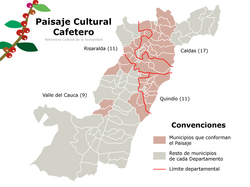Colombian coffee
| Coffee Cultural Landscape of Colombia | |
|---|---|
| Name as inscribed on the World Heritage List | |

Colombia's coffee production area is a World Heritage Site
|
|
| Location | Colombia |
| Type | Cultural |
| Criteria | v, vi |
| Reference | 1121 |
| UNESCO region | Latin America and the Caribbean |
| Inscription history | |
| Inscription | 2011 (35th Session) |
Coffee production in Colombia has a reputation as producing mild, well balanced coffee beans. Colombia's average annual coffee production of 11.5 million bags is the third total highest in the world, after Brazil and Vietnam; though highest in terms of the arabica bean. The beans are exported to United States, Germany, France, Japan, and Italy. Most coffee is grown in the Colombian coffee growing axis region. In 2007, the European Union granted Colombian coffee a protected designation of origin status. In 2011 UNESCO declared the “Coffee Cultural Landscape” of Colombia, a World Heritage site.
The coffee plant had spread to Colombia by 1790. The oldest written testimony of the presence of coffee in Colombia is attributed to a Jesuit priest, José Gumilla. In his book The Orinoco Illustrated (1730), he registered the presence of coffee in the mission of Saint Teresa of Tabajé, near where the Meta river empties into the Orinoco. Further testimony comes from the archbishop-viceroy Caballero y Gongora (1787) who registered the presence of the crop in the north east of the country near Giron (Santander) and Muzo (Boyaca) in a report that he provided to the Spanish authorities.
The first coffee crops were planted in the eastern part of the country. In 1835 the first commercial production was registered with 2,560 green coffee bags that were exported from the port of Cucuta, near the border with Venezuela. A priest named Francisco Romero is attributed to have been very influential in the propagation of the crop in the northeast region of the country. After hearing the confession of the parishioners of the town of Salazar de la Palmas, he required as penance the cultivation of coffee. Coffee became established in the departments of Santander and North Santander, Cundinamarca, Antioquia, and the historic region of Caldas.
...
Wikipedia
